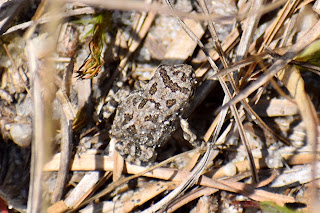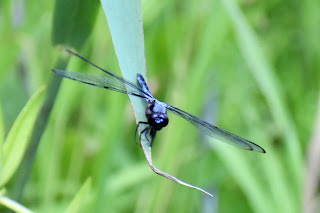Friday, I went over to the Toms River Veterans Complex to walk the power line cut trail behind the back parking lot. It was a hot summer day so birds were not the primary focus of the walk. It’s a good habitat with native plants and weeds, grasses, woods and ephemeral pools. My friends Doug and Chelsea brought this location to my attention a year or two ago.
I only managed a little over an hour there as the persistent sweat running into my eyes became unmanageable. I had about a little over a dozen bird species. Several field sparrows were singing. A yellow-billed cuckoo was calling. A pair of red-tailed hawks were perched on one of the power line towers. There was plenty of other summertime wildlife though. A mini herd of deer grunted at me before trotting away through the woods. I spotted a small frog, a small snapper turtle and a very tiny Fowler's toad. But the insects highlighted my stroll.
Left, a Fowler’s toad, about the size of my thumbnail. © S. Weiss
Right, a green frog. © S. Weiss
A juvenile common snapper turtle. © S. Weiss
Several types of dragonflies and damselflies zipped by along my walk. Some were on the large size, and one was so dainty it looked like a strand of hair drifting through the air. A common whitetail easily caught my eye. It has dark wings with a bright white abdomen. Other large dragonflies zipping along the trail were a twelve-spotted skimmer, a bar-winged skimmer, a Halloween pennant, an Eastern pondhawk and a blue dasher. The more brilliantly colored and fragile looking damselflies buzzing about were an azure bluet and a fragile forktail. For nonexperts like myself, some of the noticeable differences between dragonflies and damselflies are dragonflies are large, and damselflies are thin and narrow; dragonflies rest with their wings out vertically or horizontally, and damselflies rest with wings at their sides; the hindwings of dragonflies are usually broader, and the damselfly hindwings and forewings are the same shape and size. These differences can be seen in the following photos.


Left, common whitetail. Right, painted skimmer. © S. Weiss
Left, blue dasher. Right, Halloween pennant. © S. Weiss
Left, azure bluet. Right, Eastern pondhawk. © S. Weiss
Right, fragile forktail. © S. Weiss
Left, bar-winged skimmer. Right, twelve-spotted skimmer. © S. Weiss
A few other insects I saw representing the butterfly family were cabbage white, common buckeyes, variegated fritillary and a wood nymph. I saw several robberflies, grasshoppers and beetles, including red milkweed beetles. They were too elusive to photograph. Unfortunately, I also saw several spotted lanternfly nymphs. These nymphs were a triangular shape, black with white spots.
Left, a variegated fritillary on sheep’s-bit. © S. Weiss
Right, a common wood nymph within the sedge grass. © S. Weiss
Left, a punctured tiger beetle. © S. Weiss
Right, a type of water strider on water-filled pothole along trail. © S. Weiss
Probably what makes this spot attractive to birds and other wildlife is the diversity of plant life. Besides the tall deciduous and evergreen trees making up the wooded areas on either side of the trail, the site is plentiful with grasses, shrubs, briars and other flora. Standing out are the different grasses, clovers and native weeds attracting pollinators. Even some of my favorites, carnivorous plants, are found here. When summer turns to fall, the bird life should increase with the migrants finding edible seeds, fruit and larvae to enjoy.
Milkweed plant and its flowers keeping bees busy. © S. Weiss
Left, common bracken. © S. Weiss
Right, Virginia meadowbeauty. © S. Weiss
Both are native species.
Left, rabbitfoot clover. © S. Weiss
Right, sweet vernal grass. © S. Weiss
Both species were introduced from Europe.
Left, sheep's-bit, an introduced species from Europe. © S. Weiss
Right, spoonleaf sundew. © S. Weiss
The sundew is a flowering carnivorous plant. The leaves have a sticky coating that traps insects. The plants enzymes digest the insects and absorbs the nutrients. This allows carnivorous plants to live in less fertile soils than other plants.




























Comments
Post a Comment